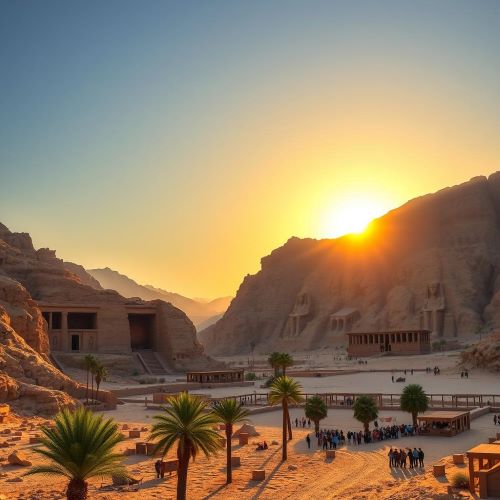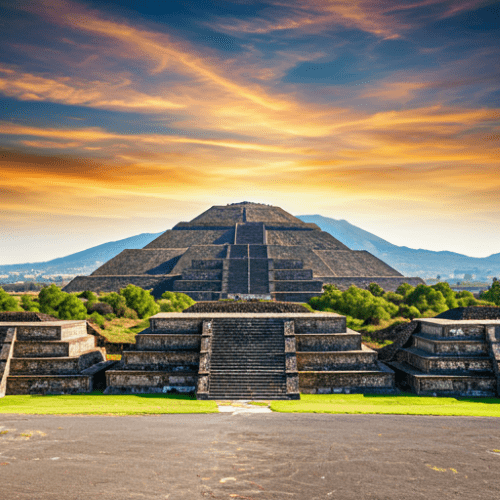Upano Valley : The Hidden City
At a glance
| Description | |
|---|---|
| Mythology | South American Mythology |
| Country | Ecuador |
| Closest airport | Francisco de Orellana Airport (OCC) |
| Type | Constructed |
| Accessibility | 06/10 |
Introduction
Tucked away in the Amazonian foothills of Ecuador, the Upano Valley has recently captured global attention—not just for its natural splendor, but for the ancient secrets it has kept buried for millennia. Lush forests, volcanic landscapes, and fertile lands define this breathtaking region. But what lies beneath the surface is just as fascinating: a sophisticated network of ancient settlements, roads, and ceremonial structures over 2,500 years old. These findings are transforming our understanding of South America’s pre-Columbian history and turning the valley into a hotbed of archaeological and ecological interest.
Connection with Mythology
The spiritual resonance of the Upano Valley is as old as the civilizations that once inhabited it. Indigenous groups such as the Kilamope, Upano, and Huapula wove tales that connected their people to celestial events and natural forces. The towering Sangay Volcano, a striking presence near the valley, is often considered sacred—believed to house guardian spirits in local mythologies. Many oral traditions speak of an era marked by a “sun change,” a metaphorical rebirth linked to divine cycles. Such stories mirror the cosmological layout of the ancient cities discovered here, suggesting that architecture, agriculture, and ritual life were deeply intertwined with myth and environment.
These mythological insights are not just relics of the past. For communities like the Sápara, the valley remains a sacred archive of ancestral knowledge and environmental wisdom—lessons they say are crucial in navigating the modern climate crisis.
Ways to Get There
Although remote, the Upano Valley is accessible with thoughtful planning. Most travelers begin their journey in the city of Macas, which serves as the primary hub for exploring the valley. Macas is connected by road to major Ecuadorian cities such as Quito and Guayaquil, with the journey taking approximately 6 to 8 hours depending on traffic and weather conditions. While flights to Macas are limited, road travel offers the added reward of stunning Andean scenery along the way.
Once in Macas, eco-tourism providers offer guided trips into the valley. These can include rafting excursions on the Upano River or trekking through the biodiverse terrain of the nearby Sangay National Park. Due to the delicate nature of the archaeological sites and the density of forest cover, local guides—often members of Indigenous communities—are essential for a safe and respectful experience.
What to Look For
Exploring the Upano Valley is like stepping into a living museum. Visitors can witness the remains of a complex civilization whose scale and sophistication rival ancient urban centers elsewhere in the world. Lidar technology has unveiled over 6,000 earthen platforms that formed the foundation of homes, temples, and communal areas. These platforms are arranged in meticulously planned layouts, connected by straight, wide roads that stretch for kilometers—an extraordinary feat of engineering in the heart of the rainforest.
But human ingenuity isn’t the only attraction here. The valley is blessed with dramatic natural scenery: the Upano River winds through deep gorges flanked by cliffs over 100 meters high, while the ever-active Sangay Volcano looms in the distance. Wildlife lovers will find themselves in paradise, with a vibrant array of flora and fauna, from rare orchids and medicinal plants to toucans, howler monkeys, and elusive jungle cats. Encounters with Indigenous groups such as the Shuar further enrich the experience, offering insights into traditional knowledge systems that have endured for centuries.
At the base of the hill lies Chalice Well, a sacred spring known for its reddish iron-rich waters. The well has long been associated with spiritual healing and Arthurian myths, and its tranquil gardens provide a serene contrast to the windswept summit. For those drawn to history, nearby Glastonbury Abbey—believed by some to be the final resting place of King Arthur—adds another layer of intrigue to this mystical landscape.
Importance in cultural history
The rediscovery of ancient cities in the Upano Valley is reshaping our understanding of the Amazon. For decades, scholars believed that the rainforest could not sustain large, complex societies. The valley defies this notion. At its peak, it may have supported tens of thousands, possibly over 100,000 people—a figure comparable to ancient London during Roman times.
Unlike stone-based empires such as the Inca, the people of the Upano Valley built with earth, crafting elevated platforms, ceremonial plazas, and canal networks that reveal a mastery of landscape engineering. Their approach to urban planning—sometimes referred to as “garden urbanism”—blended habitation, ritual, and agriculture in a harmonious whole.
This region also played a key role in the academic awakening of Amazonian archaeology. Jesuit archaeologist Pedro Porras was one of the first to document these sites in the 1970s. His early work laid the groundwork for more recent studies using lidar, satellite imaging, and community-led research. Today, the valley is seen not only as an archaeological treasure but as a symbol of Indigenous resilience and intellectual achievement.
Best time to travel
Planning a visit to the Upano Valley requires attention to the seasonal rhythms of the Amazon. The region experiences two main seasons:
-
Dry Season (June to November): This is the most favorable time to explore the valley. Trails are more accessible, visibility is better for photography and sightseeing, and river activities such as rafting or canoeing are at their safest. Cooler evenings and moderate daytime temperatures make hiking especially enjoyable.
-
Wet Season (December to May): Though the rainforest becomes even more lush and vibrant during this time, heavy rains can disrupt travel plans. Roads may become impassable, and river levels can rise dramatically, limiting access to remote sites.
For optimal conditions, travelers often aim for visits in June, July, or August, when rainfall is at its lowest and temperatures are comfortable. Regardless of the season, packing appropriate gear—lightweight raincoats, waterproof boots, insect repellent, and sun protection—is essential for a smooth journey.
Source
BBC Travel. (2024, January 23). The discovery of the Americas’ long-lost ‘Rome’. https://www.bbc.com/travel/article/20240122-the-discovery-of-the-americas-long-lost-rome
The Art Newspaper. (2024, January 19). Why the ancient Amazonian cities recently discovered in Ecuador suggest a radical rethinking of Amazonian history. https://www.theartnewspaper.com/2024/01/19/ecuador-amazonian-settlements-lidar-upano-valley
Wikipedia contributors. (n.d.). Upano Valley sites. Wikipedia. https://en.wikipedia.org/wiki/Upano_Valley_sites
Mongabay. (2025, May 26). Meet Pedro Porras, the priest who first rediscovered Amazon ancient cities. https://news.mongabay.com/2025/05/meet-pedro-porras-the-priest-who-first-rediscovered-amazon-ancient-cities/
Scientific American. (2024, January 11). Ancient Amazon civilization developed unique form of ‘garden urbanism’. https://www.scientificamerican.com/article/ancient-amazon-civilization-developed-unique-form-of-garden-urbanism/
Amazon Adventures. (n.d.). Sacred Waterfalls Rafting Tour. https://www.amazonadventures.com/sacred-waterfalls-rafting-tour.html
Mashpi Lodge. (2023, December 26). Best time to visit the Amazon Rainforest. https://www.mashpilodge.com/blog/nature/best-time-to-visit-the-amazon-rainforest/
Frequently Asked Questions
Lorem ipsum dolor sit amet, consectetur adipiscing?
Lorem ipsum dolor sit amet, consectetur adipiscing elit. Praesent convallis vestibulum justo, ac tincidunt nunc vehicula quis. Nullam id dolor quis orci malesuada feugiat. Curabitur aliquet libero at urna ullamcorper, ac ultricies nulla dapibus.
Lorem ipsum dolor sit amet, consectetur adipiscing?
Lorem ipsum dolor sit amet, consectetur adipiscing elit. Praesent convallis vestibulum justo, ac tincidunt nunc vehicula quis. Nullam id dolor quis orci malesuada feugiat. Curabitur aliquet libero at urna ullamcorper, ac ultricies nulla dapibus.
Lorem ipsum dolor sit amet, consectetur adipiscing?
Lorem ipsum dolor sit amet, consectetur adipiscing elit. Praesent convallis vestibulum justo, ac tincidunt nunc vehicula quis. Nullam id dolor quis orci malesuada feugiat. Curabitur aliquet libero at urna ullamcorper, ac ultricies nulla dapibus.
Lorem ipsum dolor sit amet, consectetur adipiscing?
Lorem ipsum dolor sit amet, consectetur adipiscing elit. Praesent convallis vestibulum justo, ac tincidunt nunc vehicula quis. Nullam id dolor quis orci malesuada feugiat. Curabitur aliquet libero at urna ullamcorper, ac ultricies nulla dapibus.
Lorem ipsum dolor sit amet, consectetur adipiscing?
Lorem ipsum dolor sit amet, consectetur adipiscing elit. Praesent convallis vestibulum justo, ac tincidunt nunc vehicula quis. Nullam id dolor quis orci malesuada feugiat. Curabitur aliquet libero at urna ullamcorper, ac ultricies nulla dapibus.









